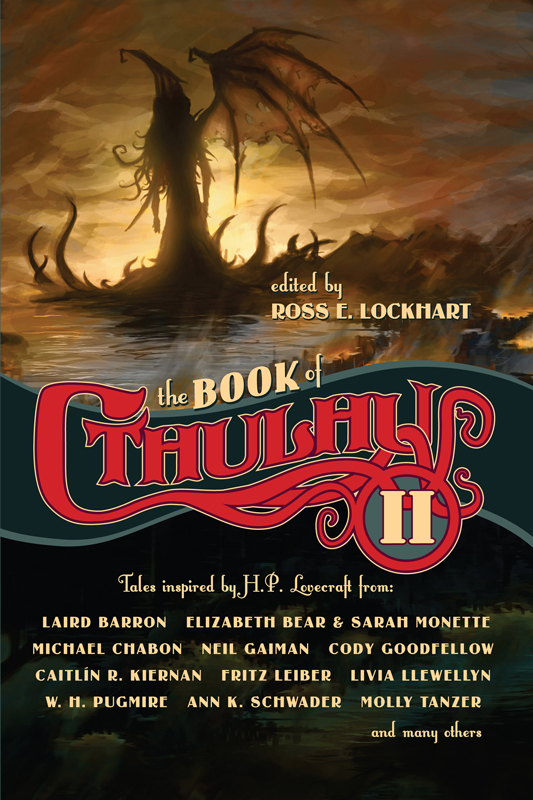Book Review: The Book of Cthulhu II edited by Ross E. Lockhart
It’s spooky stuff month again, so I sat down with this thick volume (24 stories) of tales inspired by the works of H.P. Lovecraft for a couple of weeks. This is a sequel to The Book of Cthulhu that I reviewed earlier on this blog. In the introduction, editor Lockhart primarily talks about the collaborative nature of the Mythos, which encouraged authors both enthusiastic and opportunistic to contribute their bits.

“Shoggoth’s Old Peculiar” by Neil Gaiman starts us off with a more light-hearted take. An American tourist stumbles into Innsmouth (the original British village, not the more famous American one) and gets taken under the wing of two old codgers in the local pub. While he survives mostly intact, he develops an urge to live as far from the ocean as possible.
“Hand of Glory” by Laird Barron ends the volume with a hard-boiled tale of a Washington state hitman who learns that a certain recluse sent colleagues to kill him. A recluse who may also be responsible for the death of the hitman’s father. Johnny Cope may be getting in way over his head with this mumbo-jumbo stuff. A bit of a coincidence–the “man on a horse” clip that features in the recent movie Nope is also relevant here.
Like the previous volume, most of the stories are from the more recent generation of writers, but we do have two from the 1970s.
“Sticks” by Karl Edward Wagner concerns a horror illustrator who stumbles across a series of odd wooden lattices in the woods. He should perhaps have been more suspicious when someone asks that he recreate them to illustrate a new anthology. It doesn’t feel dated.
“The Terror from the Depths” by Fritz Leiber, on the other hand, does show its age. It’s an old-style Lovecraftian pastiche, detailing our doomed narrator’s life from birth to inevitable horrific death. It’s stuffed with references to other Mythos tales, most irrelevant to the plot, and takes forever to get to the actual horrific part of tunnels honeycombing the Hollywood hills. It’s not a bad story, but it creaks at the joints. There’s even a framing device of the narrator’s journal being found after the disaster.
A few other standouts:
“The Big Fish” by Kim Newman is a noir-ish detective story set in the early days of (the American involvement in) World War Two. A private eye is hired to track down an ex-boyfriend who used to be a big shot in the mob, and also his baby with the client, which is why she cares. There’s a bit of a contrast between the internment of California’s Japanese-American population, and what is going on with more sinister alien inhabitants. The detective’s plotline intersects with more experienced Mythos investigators who are handling the larger picture, like a Call of Cthulhu game as seen by one of the guest NPCs.
“Once More, From the Top…” by A. Scott Glancy turns out to be in the Delta Green continuity as agents from that secret government organization debrief the last known survivor of the Marines that “cleaned up” Innsmouth at the end of Lovecraft’s “The Shadow Over Innsmouth.” Reference is made to how seemingly similar it was at first to missions the Marines had performed upon villages in certain “banana republics” during the 1920s.
“The Hour of the Tortoise” by Molly Tanzer has a pornography writer called back to her biological father’s house when he lays dying. Her half-brother and the servants are not initially thrilled to see her, claiming that the letter summoning her could not have come from anyone there. Like any enterprising author, Chelone is busy fictionalizing her experiences for her latest lurid tale of illicit love. But will her editor recognize the subtle cry for help?
H.P. Lovecraft himself is often referenced in these stories, usually offstage and in rather unflattering terms. The one partial exception is “A Gentleman from Mexico” by Mark Samuels, but the gentleman in question is quick to point out that he cannot possibly really be the reincarnation of Lovecraft, and therefore must be a delusional fan who just happens to write exactly like the original.
Content note: This is, after all, a horror anthology, so there’s plenty of gruesomely described death to go around, including of children. Suicide, incest, period racism and sexism.
Overall, a good selection of Cthulhu Mythos and Lovecraftian stories for the fan of such. Most of you should know who you are. If you’re not sure, you might want to try reading individual stories of this type before investing in a big anthology.

